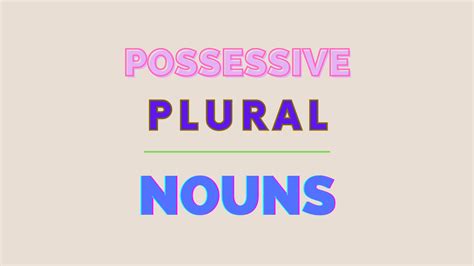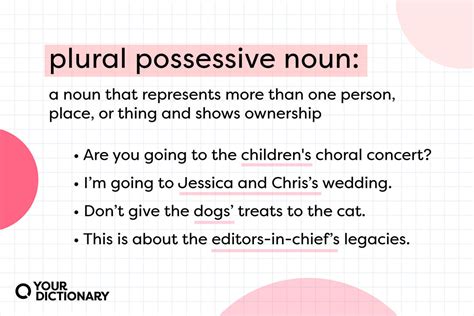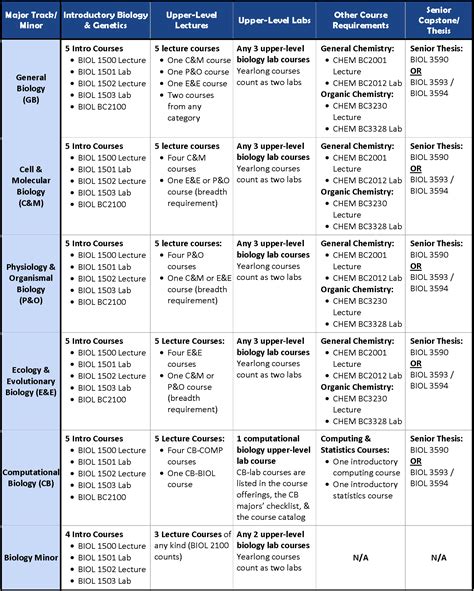Understanding the proper use of plural and possessive nouns is essential for effective communication in the English language. Mastering these grammatical concepts can significantly enhance the clarity and coherence of written and spoken language. In this comprehensive guide, we will delve into the rules and exceptions governing plural and possessive nouns, providing readers with a thorough understanding of how to apply these concepts in various contexts.
Introduction to Plural Nouns

Plural nouns refer to more than one instance of a person, place, thing, or idea. Forming plural nouns typically involves adding -s or -es to the singular form of the noun. For example, the plural form of “cat” is “cats,” and the plural form of “brush” is “brushes.” However, there are several exceptions to this rule, including nouns that end in -s, -x, -z, -sh, -ch, or -o, which often require the addition of -es to form the plural. A notable example is the noun “photo,” which becomes “photos” in its plural form.
Irregular Plural Nouns
Certain nouns do not follow the standard rules for forming plurals. These irregular plural nouns often have unique plural forms that must be memorized. Examples include “child” becoming “children,” “foot” becoming “feet,” and “tooth” becoming “teeth.” Understanding these irregular forms is crucial for accurate communication. For instance, the plural form of “deer” remains “deer,” regardless of the context in which it is used.
| Category | Examples |
|---|---|
| Regular Plurals | cat - cats, dog - dogs |
| Irregular Plurals | child - children, foot - feet |
| Same Form | deer - deer, fish - fish |

Possessive Nouns

Possessive nouns indicate ownership or relationship. They are formed by adding an apostrophe and -s to the singular form of the noun, or just an apostrophe to the plural form. For example, the possessive form of “cat” is “cat’s,” and the possessive form of “cats” is “cats’.” However, when dealing with plural nouns that end in -s, the possessive form is created by adding only an apostrophe. A common example is the possessive form of “Williams,” which becomes “Williams’.”
Joint and Separate Possession
Joint possession involves two or more individuals sharing ownership, which is indicated by placing the apostrophe and -s after the last noun. Separate possession, on the other hand, involves each individual having their own item, which requires each noun to be possessive. For instance, “John and Mary’s car” indicates they share a car, while “John’s and Mary’s cars” shows they each have their own car.
Key Points
- Plural nouns are formed by adding -s or -es to the singular form, with exceptions for nouns ending in -s, -x, -z, -sh, -ch, or -o.
- Irregular plural nouns have unique plural forms that must be memorized, such as "child" to "children."
- Possessive nouns are formed by adding an apostrophe and -s to singular nouns or just an apostrophe to plural nouns.
- Joint possession is indicated by placing the apostrophe and -s after the last noun, while separate possession requires each noun to be possessive.
- Understanding the differences between plural and possessive nouns is crucial for clear and effective communication.
Mastering the rules and exceptions for plural and possessive nouns can significantly enhance one's writing and speaking skills. By recognizing the various forms and applications of these nouns, individuals can convey complex ideas with precision and clarity. Whether in academic, professional, or casual contexts, the proper use of plural and possessive nouns contributes to the overall coherence and impact of the message being communicated.
What is the primary difference between plural and possessive nouns?
+The primary difference between plural and possessive nouns lies in their function. Plural nouns indicate more than one instance of a noun, while possessive nouns indicate ownership or relationship.
How are irregular plural nouns formed?
+Irregular plural nouns do not follow the standard rules for forming plurals. Instead, they have unique plural forms that must be memorized, such as "child" becoming "children" or "foot" becoming "feet."
What is the difference between joint and separate possession in possessive nouns?
+Joint possession involves two or more individuals sharing ownership, indicated by placing the apostrophe and -s after the last noun. Separate possession involves each individual having their own item, requiring each noun to be possessive.
In conclusion, the proper use of plural and possessive nouns is a fundamental aspect of the English language, essential for clear and effective communication. By understanding the rules, exceptions, and applications of these nouns, individuals can refine their language skills, ensuring that their messages are conveyed with precision and impact.



